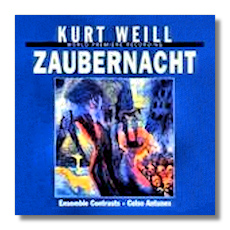
The Internet's Premier Classical Music Source
Related Links
- Weill Reviews
- Latest Reviews
- More Reviews
-
By Composer
-
Collections
DVD & Blu-ray
Books
Concert Reviews
Articles/Interviews
Software
Audio
Search Amazon
Recommended Links
Site News
 CD Review
CD Review
Kurt Weill

Zaubernacht
Ingrid Schmithüsen, soprano
Ensemble Contrasts Köln/Celso Antunes
Capriccio 67011 58:50
Summary for the Busy Executive: Mentholated chocolate cigarettes, for the kids.
Weill's artistic maturity, even at a young age, always amazes me. Born in 1900, he produced great work by his late teens and signature pieces in his early twenties. The "ballet pantomime" Zaubernacht (magic night) comes from 1922, while he still studied with Busoni. His first work for the stage to have survived in any form, also his first commission, and very likely his first music heard in the United States, the original score remains lost. We do have a piano rehearsal score (with a couple of pages missing), newspaper accounts of the première, an orchestra work (the Quodlibet) derived largely from the ballet, as well as references in a few of Weill's letters. For this CD, the piece has been realized and completed by Meirion Bowen, best known, I think, as Michael Tippett's musical assistant.
Bowen's main concern has been to provide a "usable" work. Fortunately, these efforts have resulted in minimal changes to what Weill actually wrote. Holes in the score have been filled with similar passages found elsewhere in the ballet itself, in the Quodlibet, or in Weill's string quartet of 1918 – justifiable, since Weill himself referred to this last work quite often elsewhere in the ballet. Bowen also changed the original orchestration of nine instruments slightly: he added a clarinet and had the flutist double on piccolo. The clarinet gets music that suits it best, and the flutist doesn't have to overblow to get through the higher passages. Sounds reasonable to me.
The ballet itself – a chamber ballet, if you like – concerns what happens when the toys in the nursery come to life at night. That's about all we know, apart from hints gleaned from contemporary reviews. Fortunately, the music is abstract enough that you can fit a number of different scenarios to it. The idiom isn't quite the Kurt Weill we think of or even the Kurt Weill of the violin concerto and the first symphony. It's as if Weill went to a smorgasbord of Twenties music and took a bit here and a bit there. One finds a mélange of Expressionism, Busoni's Arlecchino, the New Classicism, perhaps a bit of Les Six, and early Hindemith, as well as a by-now rare look back to Mahler. And yet it all hangs together in a consistent new idiom, just not one that Weill stuck with. The variety and vigor of the score and of the colors Weill draws from the orchestra is prodigious. My only reservation is the fact that the music is for a children's ballet, and it's a little dry – no sugar plums here. One gets neither the sweetness of "My Ship" nor the sting of Happy End, rather an objective, "cool," vibe children may not respond to, despite an appearance from the Toy Fairy. Nevertheless, it appeals very strongly indeed to this adult.
We get a fine performance from the Cologne-based Ensemble Contrasts. Ingrid Schmithüsen, the voice of the Toy Fairy, gets one song. She's beginning to get a glassy soprano, as if the voice is about to shred, but she stops with the one song. The rest of it is a delight, as the instrumental ensemble makes its way through waltzes, sassy can-cans and fox trots, and marches, among other things. For me, it's a Telemann suite, modernized. Antunes, a Brazilian with a European career, keeps everything moving. It may not be essential Weill, but it's certainly enjoyable.
Copyright © 2008, Steve Schwartz


















